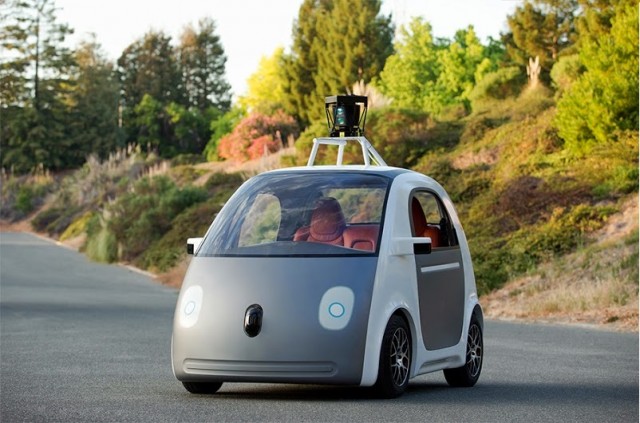Google has been steadily testing and developing autonomous, driverless cars for some time now. It's a project inspired by the tragic death of a friend of Google big cheese Sergei Brin in a car accident. Brin, being one of the ultimate computer geeks, figured that one of the biggest problems facing vehicle safety was simply the fallibility of human drivers. Take that out of the equation and millions of lives and injuries could be saved.
The project started with modified Toyotas and Audis, but now the Google car is taking a major leap forward with this, the little two-seater you see in the photos. Yes, it bears a remarkable resemblance to Nick Jnr TV character Rolie Polie Olie, but ignoring the cartoon facade for a moment, this could yet prove to be one of the most epochal cars of all time.
It's mechanically very simple. Two seats, an electric motor similar to the one used by Fiat in the 500e and enough range for around 160km. As a user or customer, the idea is that you summon one via a smartphone app and it takes you where you want to go. With a top speed of just under 50km/h, the cars are designed for purely urban use, a decision that also gets them around some of the tougher vehicle regulatory obstacles. The front is made of soft foam, just in case everything goes wrong and its 600-foot radius sensor array fails to spot a pedestrian or animal running out in front.
Google ultimately wants to build and supply these cars with no steering wheel and no pedals, just an emergency stop button as a manual override. For the moment at least, California law requires them to be built with a wheel and pedals but you can bet Google has a veritable army of lawyers working on that.
One significant suggestion for the use of these cars is as a replacement for a city's taxi fleet. Taking New York as an example, Google estimates that its driverless cars could supply the needs of that city with fewer cars than the current driven taxi fleet, and at around one eighth the current per-kilometre cost to the customer.
Anything else?
Google has been steadily testing and developing autonomous, driverless cars for some time now. It's a project inspired by the tragic death of a friend of Google big cheese Sergei Brin in a car accident. Brin, being one of the ultimate computer geeks, figured that one of the biggest problems facing vehicle safety was simply the fallibility of human drivers. Take that out of the equation and millions of lives and injuries could be saved.
The project started with modified Toyotas and Audis, but now the Google car is taking a major leap forward with this, the little two-seater you see in the photos. Yes, it bears a remarkable resemblance to Nick Jnr TV character Rolie Polie Olie, but ignoring the cartoon facade for a moment, this could yet prove to be one of the most epochal cars of all time.
It's mechanically very simple. Two seats, an electric motor similar to the one used by Fiat in the 500e and enough range for around 160km. As a user or customer, the idea is that you summon one via a smartphone app and it takes you where you want to go. With a top speed of just under 50km/h, the cars are designed for purely urban use, a decision that also gets them around some of the tougher vehicle regulatory obstacles. The front is made of soft foam, just in case everything goes wrong and its 600-foot radius sensor array fails to spot a pedestrian or animal running out in front.
Google ultimately wants to build and supply these cars with no steering wheel and no pedals, just an emergency stop button as a manual override. For the moment at least, California law requires them to be built with a wheel and pedals but you can bet Google has a veritable army of lawyers working on that.
One significant suggestion for the use of these cars is as a replacement for a city's taxi fleet. Taking New York as an example, Google estimates that its driverless cars could supply the needs of that city with fewer cars than the current driven taxi fleet, and at around one eighth the current per-kilometre cost to the customer.

